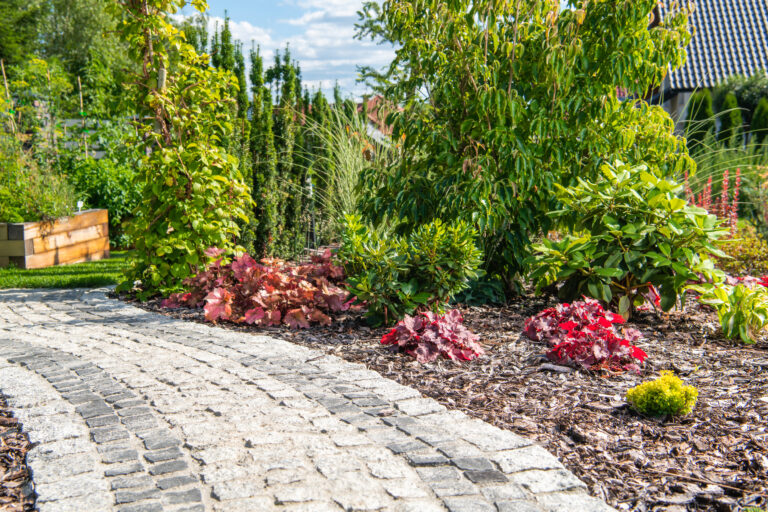Table of Contents
Step 1: Plan Your Design
Every successful landscaping project starts with a plan. Walk through your yard and decide where rock will make the most impact. Common uses include:
Garden beds around shrubs, trees, and flowers
Walkways and pathways
Borders along fences or driveways
Drainage areas to prevent erosion
Sketch your design on paper or use landscaping software to visualize the layout. Measure the length and width of each area to calculate square footage—this will help determine how much rock you need.
Pro Tip: Always order about 5–10% more rock than your calculations suggest. This extra material accounts for settling and ensures full coverage.
Step 2: Choose the Right Rock
Not all landscape rocks are created equal. The size, color, and texture you choose will influence both aesthetics and functionality. For a full breakdown of rock types, sizes, and colors that work best around homes, check out our guide: Landscaping Rocks to Use Around Homes: Type, Size and Color
Pea Gravel – Small, smooth stones, perfect for pathways and play areas.
River Rock – Rounded, medium-to-large stones, great for garden beds and drainage.
Crushed Stone – Angular and compactable, ideal for driveways and walkways.
Lava Rock – Lightweight and decorative, excellent for flower beds.
Boulders – Large accent rocks, often used as focal points in gardens.
When selecting rock, think about:
Maintenance level: Larger rocks stay in place better; smaller rocks may shift.
Color scheme: Choose a tone that complements your home’s exterior.
Functionality: Avoid sharp-edged stones in areas where people walk barefoot.
Step 3: Prepare the Ground
Proper preparation is key to a lasting installation. Start by clearing the area of grass, weeds, roots, and debris. Use a sod cutter or shovel to remove existing turf if needed.
Next, level the ground using a rake. For sloped areas, grade the soil so water drains away from your house. Compact the soil slightly with a tamper to create a firm base.
Pro Tip: If the soil is uneven, add a layer of sand or crushed stone before laying landscape fabric. This provides stability and prevents rocks from sinking into the ground over time.
Step 4: Install Landscape Fabric
Weed growth is one of the biggest challenges in rock beds, so installing landscape fabric is essential. Spread the fabric across the prepared soil, making sure seams overlap by at least 6 inches. Secure the fabric with landscape staples every 1–2 feet.
Cut X-shaped openings in the fabric if you plan to keep existing plants or install new ones.
Pro Tip: Avoid cheap, thin fabric—it tears easily and allows weeds to break through. A heavy-duty, UV-resistant fabric will last much longer.
Step 5: Add a Rock Border (Optional but Recommended)
Edging keeps rocks contained and gives your project a finished look. Popular edging options include:
Steel or aluminum edging – Sleek and modern.
Plastic edging – Affordable and flexible for curves.
Natural stone or brick – Classic and durable.
Install edging before spreading rocks to save time and effort.
Step 6: Spread the Rocks
Transport rocks using a wheelbarrow, then shovel and rake them evenly over the fabric. Aim for a depth of 2–3 inches for small to medium rocks and 3–4 inches for larger stones.
Work in small sections to maintain consistency and prevent fabric damage. Use a landscape rake to spread rocks evenly, ensuring there are no bare spots. For a deeper breakdown of techniques, see our guide: How to Spread Landscape Rock: Your Complete Guide to Installation
Pro Tip: Don’t pile rocks directly against plant stems or tree trunks—it can cause rot. Leave a few inches of space.

Step 7: Compact and Smooth
Once all rocks are in place, walk over the area or lightly tamp them down to help them settle. Then rake the surface until it looks even and polished.
Step back and check your work from multiple angles to catch thin spots or uneven areas. Add extra rock where needed.
Since rocks come in so many shapes, sizes, and colors, choosing the right type can feel overwhelming. To help you decide, check out our guide: Landscaping Rocks to Use Around Homes: Type, Size and Color for tips on selecting the perfect stone for your yard.
Step 8: Ongoing Maintenance
While landscape rock is low-maintenance, it’s not completely maintenance-free. Keep your beds looking sharp with these tips:
Pull weeds as soon as they appear. (Even with fabric, some may grow.)
Use a blower or broom to remove leaves and debris.
Add a fresh layer of rock every 3–5 years to maintain coverage.
Re-rake occasionally to keep the surface even.



